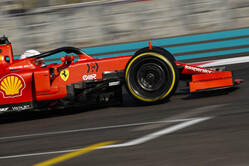


19/01/2022
NEWS STORY
 Pirelli's Mario Isola says that the early signs are that drivers will be able to push harder on the new 18-inch tyres, while data from the teams suggests the new cars will soon match the pace of their predecessors.
Pirelli's Mario Isola says that the early signs are that drivers will be able to push harder on the new 18-inch tyres, while data from the teams suggests the new cars will soon match the pace of their predecessors.
Among the many changes for 2022 is the long-awaited switch from 13-inch to 18-inch tyres. The 13-inch version has been in use for nearly the entire history of the championship to date, certainly from the 1960s. Nonetheless, at that time – and into the subsequent decade – there was still a lot of regulatory freedom around wheel size until, in the 1980s, 13-inches finally became the definitive size.
With a bigger emphasis on technological proximity to the road car as well as aesthetics, the 18-inch tyres for 2022 have the same tread width as before (305 millimetres at the front and 405 millimetres at the rear) but a slightly bigger overall diameter, which grows from 660 millimetres to 720 millimetres.
The most significant change is a reduction in the sidewall, which now resembles that of the low-profile tyres that for years have been the preferred choice of the world's leading performance road cars.
This new profile will change the behaviour of the F1 cars on track, making them more precise when changing direction. From the tests carried out so far, in both dry and wet conditions, driver feedback has been positive and it is hoped the new tyres will contribute to even more competitive races, with cars that are less sensitive to aerodynamic turbulence while following behind one another. The lower sidewall also means that the tyre will flex less, meaning that it will have less impact on the overall aerodynamics of the car. All of which should favour close racing.
The compounds for the 18-inch tyres will also be completely new, to ensure maximum consistency and less overheating. Five compound grades will be available, three of which will be chosen for each race weekend, as is the case currently.
Speaking at the presentation of its entire 2022 sporting range, which as well as F1 includes WRC and GT, Mario Isola reveals that the early signs are that drivers will be able to push harder on the new tyres, while data from the teams suggests the new cars will soon match the pace of their predecessors.
Over the course of the 2021 season, nine of the teams carried out testing of the new tyres using mule cars, with all getting to try all five compounds at the end-of-season test in Abu Dhabi.
"In terms of wear, it's difficult to make a prediction because we were using mule cars, so we need to wait for the real performance of the new 2022 cars," said Isola, according the official F1 website.
Referring to the performance difference between the 18-inch tyre and its predecessor, the Italian believes it may not be anywhere near as great as originally anticipated.
"We have simulations coming from the teams, and these simulations are telling us that the new cars are not much slower compared to last year's cars," he said. "At the beginning we were talking about more than three seconds per lap, now it's half a second, one second.
"So if they start with only one second difference it means that during the season they probably achieve the same level of performance that we had in 2021.
"In terms of comparison to the tyre development tests that we ran during the season, I would say that we have confirmed that the new product has the characteristics that I mentioned before," he added, "less overheating, drivers have the opportunity to push more.
"That was important in Abu Dhabi because in Abu Dhabi we had also some traffic. That was something we could not simulate during our tyre development test where we had one car that was running on track or two cars maximum."
Paying tribute to his team, he concluded: "In a busy season with all the constraints and 22 races, it was, I believe, a big achievement to develop the 18-inch tyre. Also, because this tyre is designed in a different way, with different targets: our drivers are asking for less overheating, less degradation, they want to push on tyres, they want to fight on track, and clearly we decided and we agreed with the FIA, FOM and the teams to follow this direction.
"So, we had to design a new profile, new construction, optimise the footprint, design a new range of compounds. It is a completely new product with a new approach, and I believe it will be quite helpful also for other activities in the company."